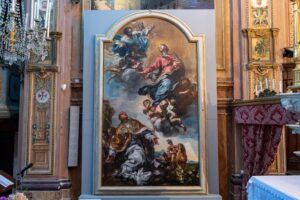Its name seems to derive from “Casal Regiium” would confirm the frequentations of the Great Orba Valley Woods by Lombard kings for their deer hunts.






What to see in Casaleggio Boiro
- Castello
- ANTICA PARROCCHIALE DI SAN LEONE
- PARROCCHIALE DI SAN MARTINO
- LAGHI DELLA LAVAGNINA E VECCHIE MINIERE DELL’ORO
It is one of the oldest buildings in Monferrato.
Some authors date it to the 10th century.
One of the most interesting details of this building, in addition to some lace decorations of the mullioned windows, is the stone relief that serves as the lintel at the entrance where a mounted knight armed with a shield and spear and a woman flanked by two lions are depicted.
It enjoys an enviable scenic location.
This characteristic made the manor house, was chosen to film some scenes of the famous TV version of Promessi Sposi directed by Sandro Bolchi.
In the script, the castle represented the eagle’s nest of the Unnamed, to which Don Abbondio went to free Lucia who was imprisoned there.
It is encountered as soon as one crosses the arch of the first circle of the castle walls, and the high altar made of wood on the upper part in the 1700s by a skilled cabinetmaker who also made the tabernacle with a niche and Corinthian columns is noteworthy.
The foundation of the church appears to have been made in the 1600s where there are reports of a funeral celebration.
The existence of the parish church dates back to 1188. Currently, the church has a single nave.
The altar on the right side is of the Immaculate Conception made like the grotto of Massabielles in Lourdes, then there is the altar dedicated to the Sacred Heart which has an antependium in polychrome marbles that date it to the 16th-17th centuries with two black marble tortiliums of great elegance.
The high altar is of considerable artistic merit where on the sides are two frescoes, “The Last Supper and ‘The Prayer of Jesus in the Garden of Olives,’ works by Gandini.
Behind the altar an extraordinarily beautiful wooden choir by the same author.
The Lavagnina Lakes are a natural beauty to visit along the Gorzente Valley.
There ancient gold mines are linked to the origin of the mythical Roman city “La Rondinaria”.
It was the Romans who first, using thousands of slaves began the business of gold mining along the banks of the Piota Creek.
The mines were active throughout the nineteenth century until the early 1900s, and at the bottom of Lavagnina Lake, during dry periods, the remains of the houses of the last gold miners are still visible.
The Piedmont Apennine Protected Areas Authority, of which the municipality is a member, has carried out work to make two of the gold mines accessible, under the guidance of park rangers, of course.
Even today, gold panning competitions are still held and several associations have sprung up.
















